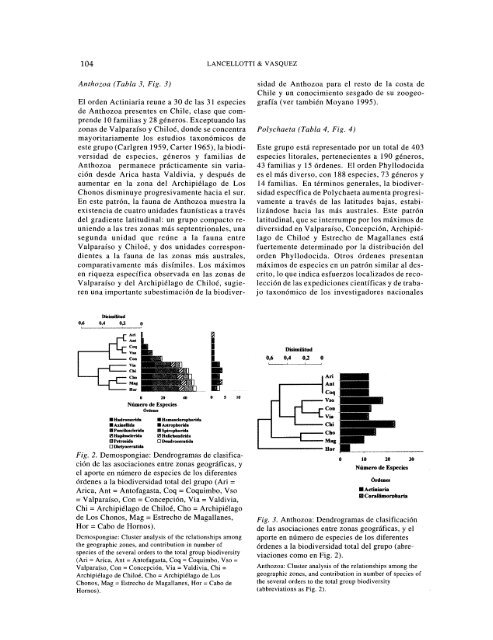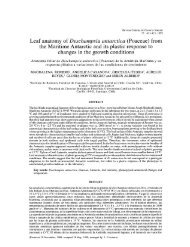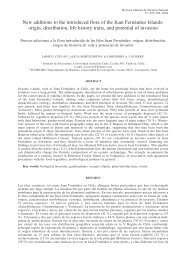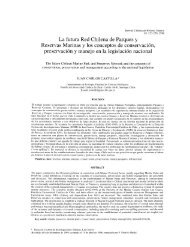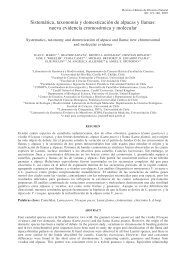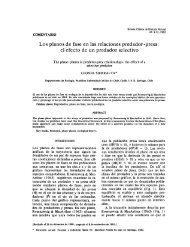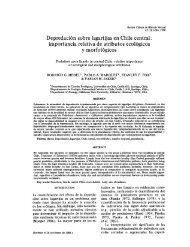Zoogeografía de macroinvertebrados bentónicos de la costa de ...
Zoogeografía de macroinvertebrados bentónicos de la costa de ...
Zoogeografía de macroinvertebrados bentónicos de la costa de ...
Create successful ePaper yourself
Turn your PDF publications into a flip-book with our unique Google optimized e-Paper software.
104 LANCELLOTTI & V ASQUEZ<br />
Anthozoa (Tab<strong>la</strong> 3, Fig. 3)<br />
El or<strong>de</strong>n Actiniaria reune a 30 <strong>de</strong> <strong>la</strong>s 31 especies<br />
<strong>de</strong> Anthozoa presentes en Chile, c<strong>la</strong>se que compren<strong>de</strong><br />
10 familias y 28 géneros. Exceptuando <strong>la</strong>s<br />
zonas <strong>de</strong> Valparaíso y Chiloé, don<strong>de</strong> se concentra<br />
mayoritariamente los estudios taxonómicos <strong>de</strong><br />
este grupo (Carlgren 1959, Carter 1965), <strong>la</strong> biodiversidad<br />
<strong>de</strong> especies, géneros y familias <strong>de</strong><br />
Anthozoa permanece prácticamente sin variación<br />
<strong>de</strong>s<strong>de</strong> Arica hasta Valdivia, y <strong>de</strong>spués <strong>de</strong><br />
aumentar en <strong>la</strong> zona <strong>de</strong>l Archipié<strong>la</strong>go <strong>de</strong> Los<br />
Chonos disminuye progresivamente hacia el sur.<br />
En este patrón, <strong>la</strong> fauna <strong>de</strong> Anthozoa muestra <strong>la</strong><br />
existencia <strong>de</strong> cuatro unida<strong>de</strong>s faunísticas a través<br />
<strong>de</strong>l gradiente <strong>la</strong>titudinal: un grupo compacto reuniendo<br />
a <strong>la</strong>s tres zonas más septentrionales, una<br />
segunda unidad que reúne a <strong>la</strong> fauna entre<br />
Valparaíso y Chiloé, y dos unida<strong>de</strong>s correspondientes<br />
a <strong>la</strong> fauna <strong>de</strong> <strong>la</strong>s zonas más australes,<br />
comparativamente más disímiles. Los máximos<br />
en riqueza específica observada en <strong>la</strong>s zonas <strong>de</strong><br />
Valparaíso y <strong>de</strong>l Archipié<strong>la</strong>go <strong>de</strong> Chiloé, sugieren<br />
una importante subestimación <strong>de</strong> <strong>la</strong> biodiver-<br />
Hadromerida<br />
o<br />
Número <strong>de</strong> ..<br />
Spirophorida<br />
Fig. 2. Demospongiae: Dendrogramas <strong>de</strong> c<strong>la</strong>sificación<br />
<strong>de</strong> <strong>la</strong>s asociaciones entre zonas geográficas, y<br />
el aporte en número <strong>de</strong> especies <strong>de</strong> los diferentes<br />
ór<strong>de</strong>nes a <strong>la</strong> biodiversidad total <strong>de</strong>l grupo (Ari =<br />
Arica, Ant = Antofagasta, Coq = Coquimbo, V so<br />
= Valparaíso, Con= Concepción, Via = Valdivia,<br />
Chi = Archipié<strong>la</strong>go <strong>de</strong> Chiloé, Cho = Archipié<strong>la</strong>go<br />
<strong>de</strong> Los Chonos, Mag = Estrecho <strong>de</strong> Magal<strong>la</strong>nes,<br />
Hor =Cabo <strong>de</strong> Hornos).<br />
Demospongiae: Cluster analysis of the re<strong>la</strong>tionships among<br />
the geographic zones, and contribution in number of<br />
species of the severa! or<strong>de</strong>rs to the total group biodiversity<br />
(Ari =Arica, Ant = Antofagasta, Coq = Coquimbo, so=<br />
Valparaíso, Con= Concepción, Vía= Valdivia, Chi =<br />
Archipié<strong>la</strong>go <strong>de</strong> Chiloé, Cho = Archipié<strong>la</strong>go <strong>de</strong> Los<br />
Chonos, Mag = Estrecho <strong>de</strong> Magal<strong>la</strong>nes, Hor = Cabo <strong>de</strong><br />
Hornos).<br />
o<br />
sidad <strong>de</strong> Anthozoa para el resto <strong>de</strong> <strong>la</strong> <strong>costa</strong> <strong>de</strong><br />
Chile y un conocimiento sesgado <strong>de</strong> su zoogeografía<br />
(ver también Moyano 1995).<br />
Polychaeta (Tab<strong>la</strong> 4, Fig. 4)<br />
Este grupo está representado por un total <strong>de</strong> 403<br />
especies litorales, pertenecientes a 190 géneros,<br />
43 familias y 15 ór<strong>de</strong>nes. El or<strong>de</strong>n Phyllodocida<br />
es el más diverso, con 188 especies, 73 géneros y<br />
14 familias. En términos generales, <strong>la</strong> biodiversidad<br />
específica <strong>de</strong> Polychaeta aumenta progresivamente<br />
a través <strong>de</strong> <strong>la</strong>s <strong>la</strong>titu<strong>de</strong>s bajas, estabilizándose<br />
hacia <strong>la</strong>s más australes. Este patrón<br />
<strong>la</strong>titudinal, que se interrumpe por los máximos <strong>de</strong><br />
diversidad en Valparaíso, Concepción, Archipié<strong>la</strong>go<br />
<strong>de</strong> Chiloé y Estrecho <strong>de</strong> Magal<strong>la</strong>nes está<br />
fuertemente <strong>de</strong>terminado por <strong>la</strong> distribución <strong>de</strong>l<br />
or<strong>de</strong>n Phyllodocida. Otros ór<strong>de</strong>nes presentan<br />
máximos <strong>de</strong> especies en un patrón simi<strong>la</strong>r al <strong>de</strong>scrito,<br />
lo que indica esfuerzos localizados <strong>de</strong> recolección<br />
<strong>de</strong> <strong>la</strong>s expediciones científicas y <strong>de</strong> trabajo<br />
taxonómico <strong>de</strong> los investigadores nacionales<br />
Disimilitud<br />
0,6 0,4 o<br />
Ari<br />
Ant<br />
Coq<br />
so<br />
Con<br />
Chi<br />
Cbo<br />
Mag<br />
Hor<br />
o<br />
Número <strong>de</strong><br />
Fig. 3. Anthozoa: Dendrogramas <strong>de</strong> c<strong>la</strong>sificación<br />
<strong>de</strong> <strong>la</strong>s asociaciones entre zonas geográficas, y el<br />
aporte en número <strong>de</strong> especies <strong>de</strong> los diferentes<br />
ór<strong>de</strong>nes a <strong>la</strong> biodiversidad total <strong>de</strong>l grupo (abreviaciones<br />
como en Fig. 2).<br />
Anthozoa: Cluster analysis of the re<strong>la</strong>tionships among the<br />
geographic zones, and contribution in number of species of<br />
the severa! or<strong>de</strong>rs to the total group biodiversity<br />
(abbreviations as Fig. 2).


